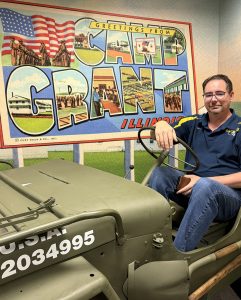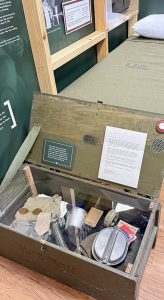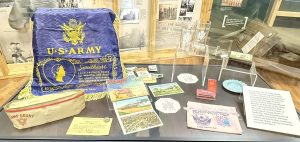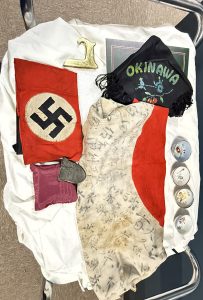Midway exhibit explores Camp Grant history
By Lynne Conner For Chronicle Media — March 2, 2025
Midway Village Museum Center marketing director Luke Fredrickson sits in a restored World War II Jeep in the Camp Grant exhibit. (Photos by Lynne Conner /For Chronicle Media)
Visitors of all ages can experience life in the military with the opening of “You’re in the Army Now: Camp Grant, Rockford’s Legacy,” a permanent interactive exhibit at Midway Village Museum Center.
A crowd of 1,200 enthusiastic patrons attended a public open house Feb. 22-23 to kick off the exhibit’s debut.
“This is the first new permanent exhibit we have had in over a decade,” said Luke Fredrickson, marketing director at Midway Village Museum. “The Camp Grant exhibit is organized in a timeline fashion so visitors can see the entire history of the camp as they stroll through the exhibit.”
As the United States entered World War I, community leaders successfully convinced the federal government to build an Army infantry training camp on a 5,600-acre site where the Chicago Rockford International Airport now operates.
“Rockford had beaten out several other Illinois cities and was chosen for an Army base named after (Civil War) General Ulysses S. Grant,” Fredrickson said. “By September 1917, over 300 buildings were constructed and over 40,000 troops had arrived.”
From World War I to the end of World War II, Camp Grant was a major driver of the city’s infrastructure and economic growth. From 1918-41, the facility housed and trained Civilian Conservation Corps workers and Illinois National Guard soldiers.
World War II saw a significant expansion, during which more than 300,000 soldiers came through Camp Grant’s gates. The camp also became a training center for medical personnel and housing for prisoners of war.
“Camp Grant closed in 1946 and ownership was transferred back to the City of Rockford, where much of the land was developed into our present-day Chicago Rockford International Airport,” Fredrickson said.

An Army bunk and footlocker with artifacts are on display as part of the exhibit.
“In 1956, local industrialist Seth B. Atwood donated money to the Rockford Park District to purchase 334 acres of the former Camp Grant (and) this became Atwood Park. The park opened an outdoor recreation and education program in 1957, which has served over 400,000 participants community-wide.”
Many exhibit artifacts came from the former Command Post Restaurant on Samuelson Road in Rockford. The diner operated out of a building that was Camp Grant’s reception facility during World War II.
“We received items soldiers used at Camp Grant, an incredible number of photographs, bugles and even non-functioning weapons,” Fredrickson said. “The Rockford community also contributed photos, artifacts and family stories about Camp Grant, which became part of the exhibit.”
Beyond Camp Grant’s history and contribution to war efforts, Fredrickson noted the economic and industrial impact the camp had and continues to have on Rockford today.
“Camp Grant was a boon to the local economy. Rockford labor, construction materials, lumber and equipment, built the camp,” he said. “Public services and roads in southeast Rockford were created because of Camp Grant, and soldiers would spend money in town, boosting the economy.”
“Experiencing the Camp Grant exhibit firsthand joins every age group in our community,”
Fredrickson said. “Some may remember wartime; some have worked at the airport or in industries built on Camp Grant land. Still, others have visited Atwood Park and appreciate its natural beauty.”

Soldiers at Camp Grant often sent souvenirs back home to their loved ones.
After Camp Grant closed, many buildings were sold to private citizens and local organizations. In 1949, a shower house for Boy Scout Camp Lowden in Ogle County was constructed from Camp Grant lumber and the camp’s Red Cross building became part of Rockford’s Red Cross facility on North Church Street. A Camp Grant quonset hut at 11th and Bildahl streets in Rockford is used for industrial storage.
Several Rockford area churches also have a connection. The first church building for St. Patrick Catholic Church on West State Street and Royal Avenue came from the camp after World War I.
Camp Grant’s World War II Catholic chapel was dismantled and moved to Loves Park, where it became the original St. Bridget Catholic Church. The Church of God on Brooke Road in Rockford was one of the chapels from the camp.
Camp Grant’s legacy is evident in the Rockford community. The land where soldiers trained more than100 years ago now serves as an outdoor learning center for generations of local schoolchildren.

Soldiers’ war keepsakes are a part of the exhibit.
High-speed jets now land where barracks once stood, and military buildings erected long ago have become the foundation of churches, homes and businesses that still stand today.
“Camp Grant is a fundamental part of our history that has not been comprehensively shared until now,” the museum’s Fredrickson said. “This fascinating exhibit connects generations in our community and underscores Camp Grant’s tremendous impact on Rockford today.”







